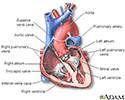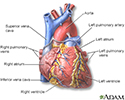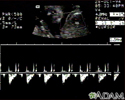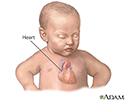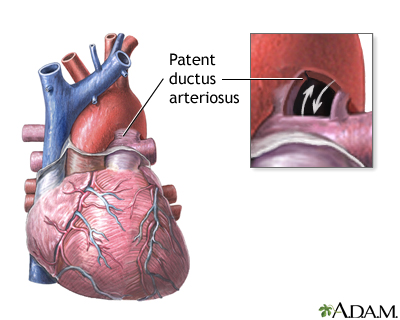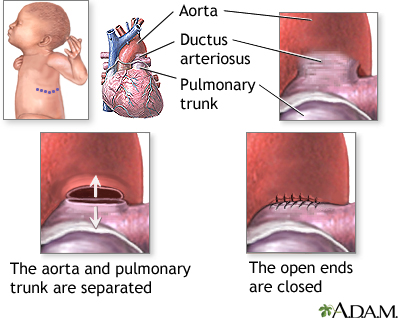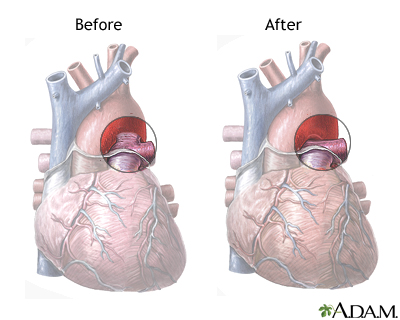Congenital heart disease
Congenital heart disease (CHD) is a problem with the heart's structure and function that is present at birth.
CHD can describe a number of different problems affecting the heart. It is the most common type of birth defect. CHD causes more deaths in the first year of life than any other birth defects.
CHD is often divided into two types: cyanotic (blue skin color caused by a lack of oxygen) and non-cyanotic. The following lists cover the most common CHDs:
Cyanotic:
- Ebstein anomaly
- Hypoplastic left heart
- Pulmonary atresia
- Tetralogy of Fallot
- Total anomalous pulmonary venous return
- Transposition of the great vessels
- Tricuspid atresia
- Truncus arteriosus
Non-cyanotic:
- Aortic stenosis
- Bicuspid aortic valve
- Atrial septal defect (ASD)
- Atrioventricular canal (endocardial cushion defect)
- Coarctation of the aorta
- Patent ductus arteriosus (PDA)
- Pulmonic stenosis
- Ventricular septal defect (VSD)
These problems may occur alone or together. Most children with CHD do not have other types of birth defects. However, heart defects may be part of genetic and chromosomal syndromes. Some of these syndromes may be passed down through families.
Examples include:
- DiGeorge syndrome
- Down syndrome
- Marfan syndrome
- Noonan syndrome
- Edwards syndrome
- Trisomy 13
- Turner syndrome
Often, no cause for the heart disease can be found. CHDs continue to be investigated and researched. Drugs such as retinoic acid for acne, chemicals, alcohol, and infections (such as rubella) during pregnancy can contribute to some congenital heart problems.
Poorly controlled blood sugar in women who have diabetes during pregnancy has also been linked to a high rate of congenital heart defects.
Symptoms
Symptoms depend on the condition. Although CHD is present at birth, the symptoms may not appear right away.
Defects such as coarctation of the aorta may not cause problems for years. Other problems, such as a small VSD, ASD, or PDA may never cause any problems.
Exams and Tests
Most congenital heart defects are found during a pregnancy ultrasound. When a defect is found, a pediatric heart doctor, surgeon, and other specialists can be there when the baby is delivered. Having medical care ready at the delivery can mean the difference between life and death for some babies.
Which tests are done on the baby depend on the defect and the symptoms.
Treatment
Which treatment is used, and how well the baby responds to it, depends on the condition. Many defects need to be followed carefully. Some will heal over time, while others will need to be treated.
Some CHDs can be treated with medicine alone. Others need to be treated with one or more heart procedures or surgeries.
Prevention
Women who are pregnant should get good prenatal care:
- Avoid alcohol and illegal drugs during pregnancy.
- Tell your health care provider that you are pregnant before taking any new medicines.
- Have a blood test early in your pregnancy to see if you are immune to rubella. If you are not immune, avoid any possible exposure to rubella and get vaccinated right after delivery.
- Pregnant women who have diabetes should try to get good control over their blood sugar level.
Certain genes may play a role in CHD. Many family members may be affected. Talk to your provider about genetic counseling and screening if you have a family history of CHD.
References
Valente AM, Dorfman AL, Babu-Narayan SV, Kreiger EV. Congenital heart disease in the adolescent and adult. In: Libby P, Bonow RO, Mann DL, Tomaselli GF, Bhatt DL, Solomon SD, eds. Braunwald's Heart Disease: A Textbook of Cardiovascular Medicine. 12th ed. Philadelphia, PA: Elsevier; 2022:chap 82.
Well A, Fraser CD. Congenital heart disease. In: Townsend CM Jr, Beauchamp RD, Evers BM, Mattox KL, eds. Sabiston Textbook of Surgery: The Biological Basis of Modern Surgical Practice. 21st ed. Philadelphia, PA: Elsevier; 2022:chap 59.
Heart - section through the middle - illustration
Heart - section through the middle
illustration
Heart - front view - illustration
Heart - front view
illustration
Ultrasound, normal fetus - heartbeat - illustration
Ultrasound, normal fetus - heartbeat
illustration
Ultrasound, ventricular septal defect - heartbeat - illustration
Ultrasound, ventricular septal defect - heartbeat
illustration
Patent ductus arteriosis (PDA) - series - Infant heart anatomy
Presentation
Heart - section through the middle - illustration
Heart - section through the middle
illustration
Heart - front view - illustration
Heart - front view
illustration
Ultrasound, normal fetus - heartbeat - illustration
Ultrasound, normal fetus - heartbeat
illustration
Ultrasound, ventricular septal defect - heartbeat - illustration
Ultrasound, ventricular septal defect - heartbeat
illustration
Patent ductus arteriosis (PDA) - series - Infant heart anatomy
Presentation
Review Date: 10/10/2021
Reviewed By: Michael A. Chen, MD, PhD, Associate Professor of Medicine, Division of Cardiology, Harborview Medical Center, University of Washington Medical School, Seattle, WA. Also reviewed by David Zieve, MD, MHA, Medical Director, Brenda Conaway, Editorial Director, and the A.D.A.M. Editorial team.














